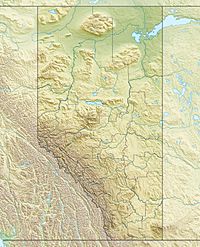Mount Brett facts for kids
Quick facts for kids Mount Brett |
|
|---|---|

Mount Brett seen from Sulphur Mountain
|
|
| Highest point | |
| Elevation | 2,984 m (9,790 ft) |
| Prominence | 899 m (2,949 ft) |
| Parent peak | Mount Ball |
| Listing | List of mountains of Alberta |
| Geography | |
| Location | Alberta, Canada |
| Parent range | Massive Range |
| Topo map | NTS 82O/04 |
| Climbing | |
| First ascent | 1916 Hogeboom, Bent, James Outram, Ritchie, McClelland |
| Easiest route | Scrambling routes from Pilot Mountain |
Mount Brett is a tall mountain in Alberta, Canada. It stands about 2,984 meters (9,790 feet) high. This amazing peak is part of the Massive Range in the beautiful Canadian Rockies.
You can find Mount Brett inside Banff National Park. It's about 20 kilometers (12 miles) west of the town of Banff. The closest higher mountain is Mount Ball, which is about 12.5 kilometers (7.8 miles) to the west.
Contents
History of Mount Brett
Mount Brett got its name in 1916. It was named after a very important person, Robert Brett (1851–1929).
Who Was Robert Brett?
Robert Brett was a doctor, a surgeon, who first came to Banff in 1885. He later became the second Lieutenant Governor of Alberta. This is a special leader who represents the King or Queen in the province. He started this important job in 1915.
First Climbers and Official Name
The first people to climb to the top of Mount Brett were C.F. Hogeboom, A.H. Bent, James Outram, E.G. Ritchie, and K.D. McClelland. They made their first successful climb in 1916. The mountain's name became official on November 2, 1956. This happened when the Geographical Names Board of Canada approved it.
How Mount Brett Was Formed
Like other mountains in Banff National Park, Mount Brett is made of sedimentary rock. This type of rock forms from layers of sand, mud, and tiny bits of sea creatures that settle over millions of years.
Rock Layers and Mountain Building
The rocks in Mount Brett were laid down during ancient times, from the Precambrian to the Jurassic periods. Imagine these rocks forming at the bottom of shallow seas! Later, during a huge event called the Laramide orogeny, these rock layers were pushed up. They were pushed east and even slid over younger rocks, creating the tall mountains we see today.
Weather Around Mount Brett
Mount Brett has a subarctic climate. This means it has very cold, snowy winters. The summers are usually mild.
Temperatures and Water Flow
In winter, temperatures can drop below -20 degrees Celsius (-4 degrees Fahrenheit). With the wind, it can feel even colder, sometimes below -30 degrees Celsius (-22 degrees Fahrenheit)! The snow and rain that fall on Mount Brett eventually melt and flow into small streams. These streams then join the Bow River, which is a large river that flows into the Saskatchewan River.


